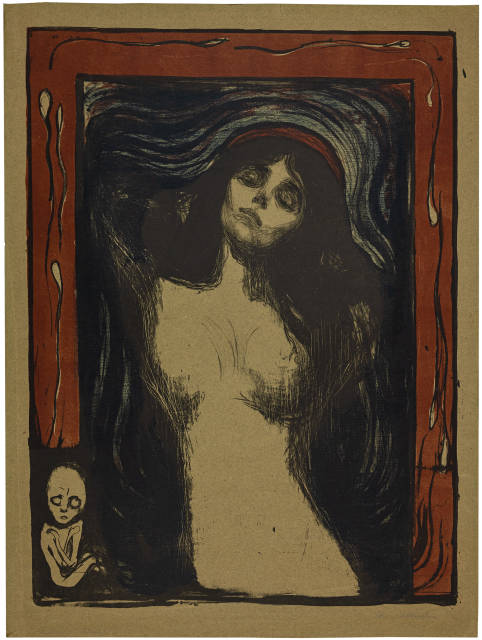- EN
Log in
- Live Auctions
- Past auctions
- More
- Gallery
- Art Dealing
- Publishing
- Kornfeld today
- The Story of Kornfeld
- Information





Sale time 13-09-2024,
about 13:40 h (CET)
(+/- 30 min)
1895-1902
Colour lithograph in black, rust red and blue on green wove paper
60.5x44.7 cm, image; 66x49.1 cm, sheet size
Signed lower right in pencil by the artist "Edv. Munch", on the left with title "Liebendes Weib"
Gerd Woll, Edvard Munch, The Complete Graphic Works, Oslo 2012, no. 39/A/III (of D/VII)
Collection F.W. Baumgartner, Denver
Auction Kornfeld, Bern, 14-17 June 1967, lot 1067
The Eberhard W. Kornfeld Collection, Bern, with the collector's stamp on the reverse, Lugt 913b
Gustav Schiefler, Verzeichnis des graphischen Werkes Edvard Munchs bis 1906, vol. I, Berlin 1907, no. 33/A/II/b (v.B)
Basel/Hovikodden 1975/1977, Kunstmuseum/Henie-Onstad-Kunstsenter, Meisterwerke der Graphik von 1800 bis zur Gegenwart: Eine Schweizer Privatsammlung [Slg. Eberhard W. Kornfeld], cat. no. 147, ill.
Salzburg/Winterthur 1984/1985, Rupertinum/Kunstmuseum, Von Goya bis Warhol, Meisterwerke der Graphik des 19. und 20. Jahrhunderts aus einer Schweizer Privatsammlung [Slg. Eberhard W. Kornfeld], cat. no. 125
Riehen 2003, Fondation Beyeler, Expressive!, p. 193, ill. p. 43
Ingelheim 2022, Kunstforum, Edvard Munch, Meisterblätter, ill. p. 125
Old creases in the paper at the bottom. A backed tear at the top centre. In particularly fine printing quality
"Madonna" (also known as "Loving Woman") is a motif that Edvard Munch worked on in five paintings and three graphic works between 1894 and 1897. The Norwegian writer Dagny Juel (1867-1901) is considered the model for the group of works. The title and composition are reminiscent of classical depictions of the Annunciation. In terms of motif, the subject belongs to Munch's "Frieze of Life", a compilation of his central works on the themes of life, love and death.
The rapturously and very expressively depicted Madonna dominates the centre of the picture, surrounded by a frame of sperm-like formations and an embryo. Gustav Schiefler wrote: "Symbolic depiction of the idea that the moment of conception, in its mixture of pleasure and suffering, summarises the sum of human destiny made up of pleasure and suffering."
Munch made one etching and two lithographs of this subject. The version offered here is considered the most important of the group. Munch completed the drawing stone in Berlin in 1895, adding three coloured stones in 1902, also in Berlin. The prints were produced by the Berlin studio Lassally.
"Madonna" is one of the artist's most iconic graphic works and is considered one of the landmarks of European printmaking in terms of content and design. The lithograph is superb in its colour quality and uses a very attractive palette.
1895-1902
Farblithographie, Steindruck in Schwarz, Rostrot und Blau auf grünem Velin
60,5x44,7 cm, Darstellung; 66x49,1 cm, Blattgrösse
Unten rechts vom Künstler in Bleistift signiert "Edv. Munch", links mit Titel "Liebendes Weib"
Gerd Woll, Edvard Munch, The Complete Graphic Works, Oslo 2012,
Slg. F.W. Baumgartner, Denver
Auktion Kornfeld, Bern, 14.-17. Juni 1967, Los 1067
Slg. Eberhard W. Kornfeld, Bern, rückseitig mit dem Sammlerstempel, Lugt 913b
Gustav Schiefler, Verzeichnis des graphischen Werkes Edvard Munchs bis 1906, Band I, Berlin 1907,
Basel/Hovikodden 1975/1977, Kunstmuseum/Henie-Onstad-Kunstsenter, Meisterwerke der Graphik von 1800 bis zur Gegenwart: Eine Schweizer Privatsammlung [Slg. Eberhard W. Kornfeld],
Salzburg/Winterthur 1984/1985, Rupertinum/Kunstmuseum, Von Goya bis Warhol, Meisterwerke der Graphik des 19. und 20. Jahrhunderts aus einer Schweizer Privatsammlung [Slg. Eberhard W. Kornfeld],
Riehen 2003, Fondation Beyeler, Expressiv!,
Ingelheim 2022, Kunstforum, Edvard Munch, Meisterblätter,
Unten alte Knitterfalten im Papier. Oben in der Mitte ein hinterlegter Einriss. In besonders schöner Druckqualität
"Madonna" (auch "Liebendes Weib" genannt) ist ein Motiv, das Edvard Munch zwischen 1894 und 1897 in fünf Gemälden und drei graphischen Arbeiten bearbeitete. Die norwegische Schriftstellerin Dagny Juel (1867-1901) gilt als Modell für die Werkgruppe. Titel und Bildanlage erinnern an klassische Darstellungen von Mariä Verkündigung. Motivisch gehört das Thema zu Munchs "Lebensfries", einer Zusammenstellung seiner zentralen Werke zu den Themen Leben, Liebe und Tod.
Die entzückt und sehr expressiv dargestellte Madonna dominiert zentral das Bildgeschehen, umgeben von einer Rahmung aus spermienartigen Gebilden und einem Embryo. Gustav Schiefler schrieb dazu: "Symbolische Darstellung der Idee, dass der Moment der Empfängnis in seiner Mischung von Lust und Leid im Grossen die Summe des aus Lust und Leid zusammengesetzten Menschenschicksals in sich schliesst."
In der Druckgraphik schuf Munch eine Radierung sowie zwei Lithographien. Die hier angebotene Version gilt als die wichtigste der Gruppe. Munch konzipierte den Zeichnungsstein 1895 noch in Berlin und ergänzte die Darstellung 1902, ebenfalls in Berlin, mit drei Farbsteinen. Die Drucke besorgte das Berliner Atelier Lassally.
"Madonna" gehört zu den ikonischen graphischen Arbeiten des Künstlers und gilt inhaltlich und gestalterisch als einer der Marksteine der europäischen Graphik. Die Lithographie ist prachtvoll in der Farbqualität und in einer farblich sehr reizvollen Fassung umgesetzt.
| Switzerland | CHF | Individual offer |
| Europe | CHF | Individual offer |
| Overseas | CHF | Individual offer |






